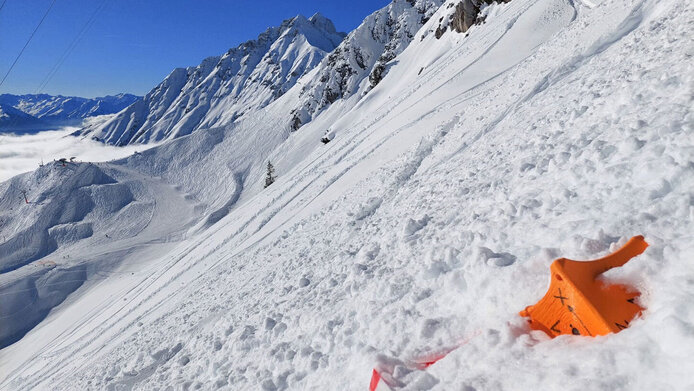An inside view of avalanches

Thanks to decades of research, the characterization, prediction and simulation of avalanches are now much more accurate. Actually “looking inside” an avalanche and gleaning a detailed understanding of the processes occurring in the snow during an event, however, is still comparatively difficult. Existing methods mainly use radar to measure the internal dynamics of avalanches, but the increasing digitalization and miniaturization of electronics has made another approach a realistic option: it is now possible to send small computers with sophisticated sensor technology along with an avalanche, enabling them to record what is going on in the midst of these difficult-to-track snow-mass movements.
“AvaRange: Particle Tracking in Snow Avalanches” is the first project to pursue this approach. It is conducted by the Austrian Research Center for Forests (BFW) together with research partners and receives support from the Austrian Science Fund FWF and the German Research Foundation (DFG). Jan-Thomas Fischer and his colleagues at the Natural Hazards Department of the BFW in Innsbruck want to use this new inside view of avalanches to complement laboratory experiments and computer simulations and thus also contribute to greater safety in winter sports.
More safety for winter sports lovers
“Classical avalanche research pays more attention to major events with their potentially disastrous consequences. In contrast, we focus on smaller avalanches, which are only indirectly relevant for things such as hazard zone planning, but can be very relevant for those engaging in winter sports on and off the slopes,” Fischer explains. Simulation tools for this area are still comparatively less refined. Improving them could help, for instance, to ensure that protective structures are correctly positioned and sized or to determine the most probable spot in the run-out zone where victims could be buried. Today, skiers in alpine terrain use special avalanche backpacks that deploy an airbag in an emergency so that their wearers are transported on the surface of the avalanche. The research results might also be used to improve these avalanche airbags.
Tests on the Innsbruck Nordkette range
Naturally occurring avalanche events are rare and difficult to observe. Hence the significant challenge for researchers to find several avalanche events with comparable overall conditions and to obtain reproducible results. The team in Innsbruck is therefore cooperating with the Nordkette ski patrol, where blasting for avalanche control is a regular occurrence when the snow conditions suggest the need.
Personal details
Jan-Thomas Fischer is a physicist who qualified as a professor and has a background in cryospheric studies and avalanche dynamics. Since 2021, he has headed the Natural Hazards Department at the Federal Forest Research Center (BFW) in Innsbruck, where he focuses on experimental and computational methods in avalanche research. His project “AvaRange: Particle Tracking in Snow Avalanches” received EUR 315,000 in funding from the FWF.
Fischer and his team are also working with experts from the University of Innsbruck and the Berlin University of Technology to design the sensor equipment. “The technology we are using is similar to that installed in an advanced smartphone. This includes elements for precise positioning via satellite navigation systems, accelerometers or gyroscopes that determine the spatial position of the sensor modules, or sensors that can accurately measure temperature development,” notes Fischer. One of the most important points is connectivity. The sensor units should be able to connect not only with measuring points outside the avalanches, but, in an advanced stage of development, also with their counterparts inside the moving snow mass. Several sensor units will form a network and continuously identify their relative positions via radio distance measurement. The sensors and electronics will be packaged in stable casings made by 3D printers, which will have to be sturdy enough to withstand the extreme conditions inside the avalanches.
Coping with chaos
It comes as no surprise that the movement of the sensor elements within the snow masses is extremely chaotic. They rotate, hit rocks, move on the surface or are buried deep within the avalanche. “Tracking these movements is relatively difficult and requires sophisticated linking of sensor data,” says Fischer. The aspects that the project investigates include the use of proprietary machine learning algorithms in order to simplify, analyze and filter the complex data output. The motion sequences provide insights into a number of internal avalanche properties, including a phenomenon that Fischer calls inverse segregation. The term denotes the formation of snow particles or clumps of snow of different sizes, with the larger particles tending to move up towards the surface – a phenomenon also exploited by the avalanche airbags mentioned earlier. This phenomenon is not, however, governed by a simple linear relationship.
“The actual movement of the snow particles within the avalanche depends on many factors, including not only their size, but also, for instance, their density and precise shape,” Fischer explains. “We want to find out in what way these properties influence and determine the flow of the snow particles in the avalanche.” One of the bases of this research are laboratory experiments which have already shown very clearly how the compact snow particles within the avalanches evolve in terms of shape and size. The insights gained by the researchers into the inner workings of avalanches will eventually also be harnessed by a new simulation tool that will be freely available to the scientific community. This tool should then also be able to map the formation and movement of the particles with a high degree of accuracy.
Publications
Oesterle F., Wirbel A., Tonnel M., Fischer J.-T.: avaframe/AvaFrame: latest Version 2022; The open Avalanche Framework: https://docs.avaframe.org/en/latest/
D’Amboise C. J. L., Neuhauser M., Teich M., Huber A., Kofler A., Perzl F., Fromm R., Kleemayr K., Fischer J.-T.: Flow-Py v1.0: a customizable, open-source simulation tool to estimate runout and intensity of gravitational mass flows, in: Geoscientific Model Development 2022
Neurauter R., Gerstmayr J.: A novel motion-reconstruction method for inertial sensors with constraints, in: Multibody System Dynamics, Springer, 1–29, 2022






